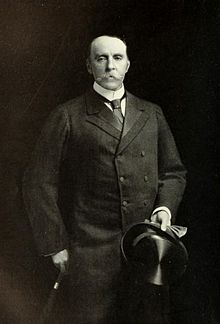Mortimer Durand

Sir Henry Mortimer Durand, GCMG KCSI KCIE (14 February 1850 – 8 June 1924) was a British diplomat and civil servant of colonial British India.
Background
Born at Sehore, Bhopal, India, he was the son of Sir Henry Marion Durand, the Resident of Baroda and he was educated at Blackheath Proprietary School, and Tonbridge School.[1]
Career
Durand entered the Indian Civil Service in 1873. During the Second Anglo-Afghan War (1878–1880) he was Political Secretary at Kabul. From 1884 to 1894, he was Foreign Secretary of India. Durand was appointed Minister plenipotentiary at Tehran in 1894 although despite being a Persian scholar and speaking the language fluently he made little impression either in Tehran or on his superiors in London. He left in 1900 by which time owing to the illness of his wife Ella he had withdrawn from social life and the legation was in a depressed and disorganised state. From 1900 to 1903 he served as British Ambassador to Spain, and from 1903-1906 as Ambassador to the United States of America. He was appointed a CSI in 1881[2] knighted a KCIE in 1888 and a KCSI in 1894[3] and appointed a GCMG in 1900.[4]
Literary works
From 1906, after his return to England, he devoted his time to writing.
He also published the biography of his father, General Henry Marion Durand (1812–1871), and had ambitions as a novelist—often with his wife, Lady E. R. Durand (1852–1913), as a co-author. Some of his publications are:
- An Autumn Tour in Western Persia (1902)
- Nadir Shah: An Historical Novel (1908)
- The Life of Field-Marshal Sir George White, V.C. (1915)
Legacy
Durand Line
This line, the Durand Line, is named after Sir Mortimer and remains the international boundary between Afghanistan and modern-day Pakistan, officially recognized by most nations but an ongoing point of contention between the two countries.
In 1884 Durand informed Abdur Rahman Khan, the Amir of Afghanistan, the frontier between modern-day Pakistan the successor state of British India and Afghanistan that the garrison of Pandjeh had been slaughtered on the orders of the Russian General Komarov. The Russians wished to stop British occupation of Herat, so Durand was despatched to prevent "the strained relations which then existed between Russia and ourselves, wrote the Viceroy, Lord Dufferin, might in itself have proved the occasion of a long miserable war." Tensions at home in British newspapers heightened the urgency of the incident, threatening war in Central Asia, which Rahman was desperate to avoid. A telephone line was kept open between Lord Granville and Count Giers in St Petersburg.[5]
Sir Mortimer was deputed to Kabul by the government of British India for the purpose of settling an exchange of territory required by the demarcation of the Joint Boundary Commission between northeastern Afghanistan and the Russian possessions along the same lines as in 1873, except for the southward salient at Pandjeh. The British made it clear that any further extension towards Herat would be amoun to a declaration of war. Rahman showed his usual ability in diplomatic argument, his tenacity where his own views or claims were in debate, with a sure underlying insight into the real situation. A Royal Commission was established to demarcate the boundary between Afghanistan and the British-governed India. The two parties camped at Parachinar, now part of FATA Pakistan, near Khost Afghanistan. From the British side the camp was attended by Mortimer Durand and Sahibzada Abdul Qayyum, the Political Agent for Khyber. The Afghans were represented by Sahibzada Abdul Latif and Governor Sardar Shireendil Khan representing Amir Abdur Rahman Khan.[6] The territorial exchanges were amicably agreed upon; the relations between the British Indian and Afghan governments, as previously arranged, were confirmed. The Durand Road in Lahore is also named after him.
Death
Durand died at Quetta, Emirate of Quetta, Sultanate of Balochistan, British Balochistan, British India, in 1924. His grave yet to be discovered however his father is buried in a Church at Dera Ismail Khan, Khyber Pakhtunkhwa Province of Pakistan.[7]
See also
- Durand Cup - a football tournament started by Mortimer Durand at Simla in 1888.
References
- ^ John F. Riddick, The history of British India, p258
- ^ London Gazette, 1 March 1881
- ^ London Gazette, 2 January 1894
- ^ London Gazette, 1 June 1900
- ^ Hopkirk, The Great Game, pp.430-1
- ^ http://www.aaiil.org/aaiil/ra/jalsa/2003/sahibzadaabdullatifshaheed100anniversary/08sahibzadazahoorahmad_sahibzadaabdullatifshaheed.mp3
- ^ "Grave Sir Henry Mortimer Durand - Wikimapia". wikimapia.org. Retrieved 2016-09-26.
- Bibliography
- Adye, Gen Sir John (1897). Indian Frontier Policy.
- Coen, T.C. (1971). The Indian Political Service.
- Durand, Col Algernon (1899). The Making of a Frontier Five Years Experence and Adventure in Gilgit, Hunsa, Nagar, Chitral and the Hindu Kush.
- Marvin, Charles (1885). The Russians at the Gate of Herat.
- Riddick, John F. The history of British India.
External links
- 1850 births
- 1924 deaths
- Administrators in British India
- Knights Grand Cross of the Order of St Michael and St George
- Knights Commander of the Order of the Star of India
- Knights Commander of the Order of the Indian Empire
- Ambassadors of the United Kingdom to the United States
- Ambassadors of the United Kingdom to Spain
- British people of the Second Anglo-Afghan War
- Durand line
- Indian civil servants
- People educated at Blackheath Proprietary School
- People from Sehore
- Members of the Privy Council of the United Kingdom
